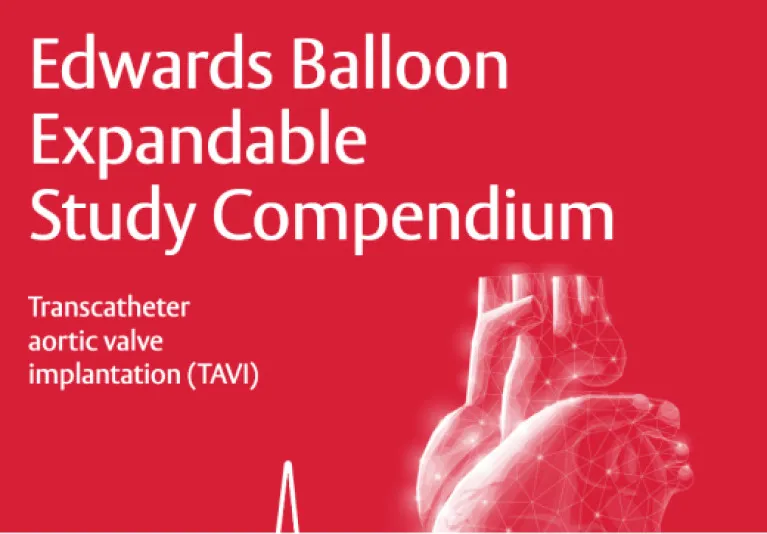PARTNER 3 Trial - TAVI shows superior outcomes compared to sAVR1
- A large prospective, multi-centre trial enrolling low surgical risk severe aortic stenosis (sAS) patients randomised to either TAVI or surgery (sAVR)
- The rate of the composite of death, stroke, or rehospitalisation at 1 year (primary endpoint) was significantly lower with
SAPIEN 3 TAVI than with sAVR - A number of prespecified secondary endpoints were also statistically significant in favour of TAVI
The PARTNER 3 Trial study design1

Inclusion and exclusion criteria
Inclusions1
Severe, calcific aortic stenosis meeting the following criteria:
- AVA ≤1.0 cm2 or AVA index ≤0.6 cm2/m2
- Jet velocity ≥4.0 m/s or mean gradient ≥40 mmHg AND
- a) NYHA Functional Class ≥II OR
- b) Exercise test that demonstrates a limited exercise capacity, abnormal BP response, or arrhythmia OR
- c) Asymptomatic with LVEF <50 %
Low risk of operative mortality and an STS <4 %
Exclusions1
Native aortic annulus size unsuitable for sizes 20, 23, 26, or 29mm THV based on 3D imaging analysis
Iliofemoral vessel characteristics that would preclude safe passage of the introducer sheath
Patients with clinical frailty, bicuspid aortic valves, or other anatomical and clinical features that increased the risk of complications associated with either TAVI or sAVR were excluded
Baseline characteristics
Baseline characteristics were well balanced in the two groups with the exception of a higher percentage of patients with an NYHA class of III or IV in the SAPIEN 3 TAVI group than in the sAVR group (31.2% vs. 23.8%, p<0.05).1*
* Plus–minus values are means ±SD.
† The body-mass index is the weight in kilograms divided by the square of the height in metres.
‡ Scoring on the risk model of the Society of Thoracic Surgeons (STS) uses an algorithm that is based on the presence of coexisting illnesses in order to predict 30-day operative mortality. The STS score equals the predicted mortality expressed as a percentage. Less than 5% of patients in the population on which the STS algorithm is based had a predicted operative mortality (risk score) of more than 10%. Data on this score were missing for one patient.
§ To convert values for creatinine to micromoles per litre, multiply by 88.4
Reported clinical and patient outcomes
SAPIEN 3 TAVI demonstrated superiority to sAVR in the composite of all-cause mortality, stroke, or rehospitalisation one year. This occurred in 42 patients (8.5%) in the SAPIEN 3 TAVI group versus 68 patients (15.1%) in the sAVR group1
- Initially test for noninferiority with an absolute difference between the groups of 6.6% in favour of TAVI (95% CI, 10.8 to 2.5%; P<0.001) thus demonstrating noninferiority
- A superiority analysis was subsequently performed comparing the two groups showing a hazard ratio of 0.54 (95% CI, 0.37 to 0.79; P = 0.001) in favour of TAVI thus demonstrating superiority
Primary endpoint : all-cause mortality, all stroke or rehospitalisation at one year 1
 PARTNER 3 Trial Clinical paper
PARTNER 3 Trial Clinical paper
The baseline characteristics of the patients in the TAVI and sAVR groups were generally well balanced.1*
*Prolonged follow-up Length of the index hospitalisation was 3 days for TAVI and 7 days for sAVR (p<0.001). Composite of death or a low KCCQ overall summary score at 30 days was 3.9% for TAVI compared to 30.6% for sAVR (p<0.001), this result was confirmed using multiple imputation for missing data.
2-year follow-up
See below the 2-year data presented at the American Cardiology Congress (ACC)/World Congress of Cardiology, March 28-30, 2020, Chicago, IL.
The prolonged follow-up, to 2 years, continues to show a statistical benefit in favour of SAPIEN 3 TAVI compared to sAVR.2
- 17.4% vs 11.5% (absolute difference 5.9%; HR 0.63 [95% CI, 0.45 to 0.88]; p=0.007)
Quality of life
The TAVI group enjoyed a better health status at 1, 6 and 12 months after the procedure compared to the sAVR group, as measured using the KCCQ-OS (Kansas City Cardiomyopathy Questionnaire – Overall Summary).3

Although the late health status benefits of TAVI are small, they are still important as they may represent a clinically meaningful improvement for a certain group of patients.3,4
Find out more about the QoL analysis and see the full outcome data
Clinical implications
What could a TAVI referral mean for your patients who match the PARTNER 3 Trial characteristics?
- Lowering your patients’ risk of death or disabling stroke at 1 year to just 1%1
- A speedy recovery to help patients get back to the life they love1
- Meaningful, early and late health status benefits which could give your patients the opportunity for a fuller life3, 4
References:
1 Mack MJ, et al. N Engl J Med. 2019;380:1695–1705 and supplementary material.
2 Mack MJ. Two-year clinical and echocardiographic outcomes from the PARTNER 3 low-risk randomized trial. Presented at: ACC 2020. March 29, 2020.
3 Baron SJ, Magnuson EA, Lu M, et al. J Am Coll Cardiol 2019; 74(23):2833-2842.
4 Baron SJ. Presentation at TCT, September 25–29, 2019; San Francisco, CA, USA.
Medical device for professional use. For a listing of indications, contraindications, precautions, warnings, and potential adverse events, please refer to the Instructions for Use (consult eifu.edwards.com where applicable).
PP–EU-0769 v2.0
